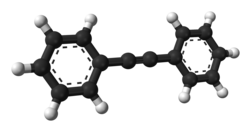Top Qs
Timeline
Chat
Perspective
Diphenylacetylene
Chemical compound From Wikipedia, the free encyclopedia
Remove ads
Diphenylacetylene is the chemical compound C6H5C≡CC6H5. The molecule consists of two phenyl groups attached to a C2 unit. A colorless solid, it is used as a building block in organic synthesis and as a ligand in organometallic chemistry.
Remove ads
Preparation and structure
In one preparation for this compound, benzil is condensed with hydrazine to give the bis(hydrazone), which is oxidized with mercury(II) oxide.[2] Alternatively stilbene is brominated, and the resulting dibromodiphenylethane is subjected to dehydrohalogenation.[3] Yet another method involves the coupling of iodobenzene and the copper salt of phenylacetylene in the Castro-Stephens coupling. The related Sonogashira coupling involves the coupling of iodobenzene and phenylacetylene.
Diphenylacetylene is a planar molecule. The central C≡C distance is 119.8 picometers.[1]
Remove ads
Derivatives
1,2,3,4-Tetraphenylbutadiene is prepared by reductive coupling of diphenylacetylene using lithium metal followed by hydrolysis of the resulting 1,4-dilithiobutadiene:[4]
- 2 PhC≡CPh + 2 Li → LiCPh=CPh−CPh=CPhLi (Ph = C6H5)
- LiCPh=CPh−CPh=CPhLi + 2 H2O → PhCH=CPh−CPh=CHPh + 2 LiOH
Reaction of diphenylacetylene with tetraphenylcyclopentadienone results in the formation of hexaphenylbenzene in a Diels–Alder reaction.[5]
Dicobalt octacarbonyl catalyzes alkyne trimerisation of diphenylacetylene to form hexaphenylbenzene.[6]
Reaction of Ph2C2 with benzal chloride in the presence of potassium t-butoxide affords 3-tert-butoxy-1,2,3-triphenylcyclopropene, which converts to 1,2,3-triphenylcyclopropenium bromide after the elimination of tert-butoxide.[7]
Remove ads
References
Wikiwand - on
Seamless Wikipedia browsing. On steroids.
Remove ads





